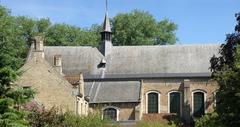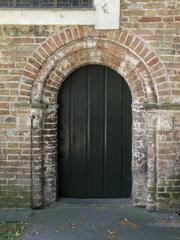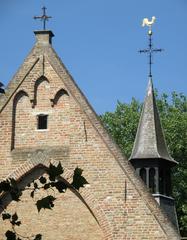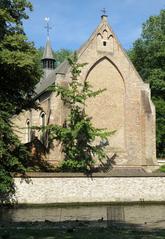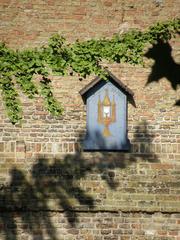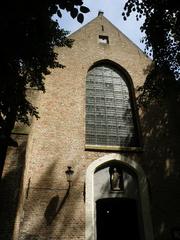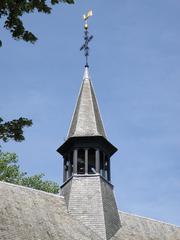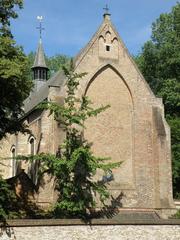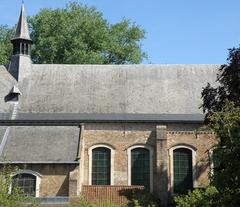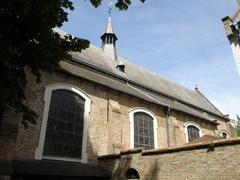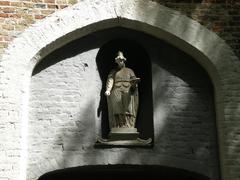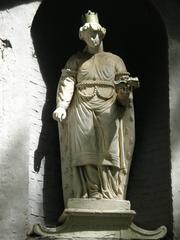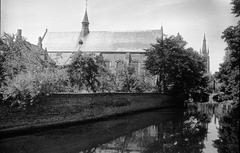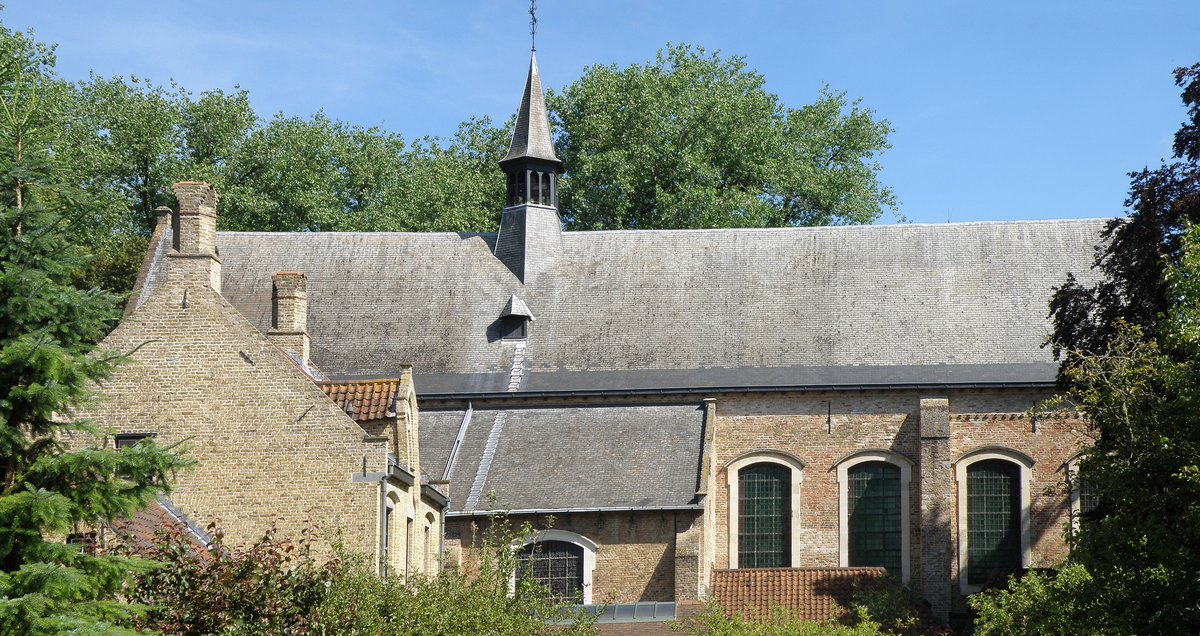
Beguinage Church Saint Elizabeth Bruges: Visiting Hours, Tickets, and Visitor Guide
Date: 14/06/2025
Introduction
The Beguinage Church of Saint Elizabeth, located in the peaceful enclave of the Princely Beguinage Ten Wijngaerde in Bruges, Belgium, stands as a testament to centuries of religious devotion, female autonomy, and architectural splendor. Founded in 1245 by Margaret of Constantinople, this historic site not only represents the unique Beguine movement but also showcases remarkable Flemish Baroque and Gothic architectural styles. Today, both the church and the surrounding Beguinage are recognized as a UNESCO World Heritage site, attracting visitors seeking history, culture, and tranquility in the heart of Bruges.
This guide provides all you need to know for planning your visit: detailed information on visiting hours, ticketing, accessibility, guided tours, nearby attractions, and essential travel tips. Explore the history, art, and significance of this remarkable Bruges historical site, and make the most of your journey with practical insights and recommendations.
For official updates and further details, consult the Visit Bruges website and the UNESCO World Heritage page.
Table of Contents
- Introduction
- Historical Overview
- Artistic and Architectural Highlights
- Cultural and Social Significance
- Visiting Information
- Facilities and Accessibility
- What to See Inside the Beguinage Church
- Special Exhibitions and Events
- Best Times to Visit
- Accessibility for Groups and Individuals
- Nearby Attractions
- Practical Tips
- Visuals and Interactive Media
- Frequently Asked Questions (FAQ)
- Contact Information
- Conclusion
- References
Historical Overview
Origins and Foundation
The Beguinage Church of Saint Elizabeth is at the heart of the Princely Beguinage Ten Wijngaerde, established in 1245 by Margaret of Constantinople, Countess of Flanders (Visit Bruges). The Beguines—lay religious women—formed semi-monastic communities that offered spiritual life, education, and charitable work without the constraints of permanent vows. This allowed women unprecedented autonomy in medieval Europe.
The Beguine Movement
Beguines led lives of prayer, work, and service, particularly in nursing and teaching, supporting themselves through crafts such as lace-making (Belgium Travel). Their communities provided an alternative to marriage or convent life and fostered female solidarity and social responsibility.
Architectural Evolution
The original church, likely Gothic in style, was destroyed by fire in 1584 but rebuilt in Baroque style between 1604 and 1609. The current church combines Baroque features—such as a single nave, rounded arches, and an understated façade—with Gothic elements, reflecting the changing religious and artistic tastes of post-Reformation Flanders (UNESCO World Heritage; marble.nd.edu).
Artistic and Architectural Highlights
Site Layout and Urban Context
The Beguinage is a self-contained settlement, entered via a monumental 1776 gateway over the Minnewater canal. Whitewashed houses and communal buildings surround a central green, creating a tranquil urban oasis (marble.nd.edu). The layout exemplifies medieval urban planning, balancing private and communal spaces.
Church Exterior and Interior
- Exterior: The church’s brick façade is simple and harmonious, with tall arched windows and a modest bell tower rising above the rooftops.
- Interior: The nave is spacious and serene, with whitewashed walls and a wooden barrel-vaulted ceiling. The sanctuary features a Baroque altarpiece depicting Saint Elizabeth of Hungary, the community’s patroness.
Artistic Elements and Symbolism
- High Altar & Side Chapels: The Baroque high altar is adorned with gilded woodwork and statues. Side chapels honor the Virgin Mary and other saints.
- Pulpit & Confessionals: Ornate Flemish woodcarving, notably in the pulpit, exemplifies 17th- and 18th-century craftsmanship.
- Stained Glass: The church’s windows are filled with clear and tinted glass, creating a contemplative atmosphere.
- Other Features: Carved confessionals, wrought ironwork, and religious paintings enrich the interior (marble.nd.edu).
Cultural and Social Significance
Female Autonomy and Social Innovation
The Beguinage was revolutionary as a “city of women,” giving women a choice between marriage and convent life (Spotting History). It fostered female independence, education, and social service long before these became mainstream values.
Religious and Spiritual Heritage
The church and Beguinage have served as a place of worship and contemplation since the 13th century (Visit Bruges). The community’s spiritual focus is reflected in the site’s continued reputation as a “silent spot” in busy Bruges, maintained by its current residents—Benedictine nuns and laywomen (Brugge Foundation).
Urban and Architectural Importance
The Beguinage is a rare example of an urban settlement designed for women, with its harmonious architecture and integration into Bruges’ cityscape contributing to its UNESCO World Heritage designation (Brugge Foundation).
Intangible Heritage: Silence and Biodiversity
The Beguinage’s traditions of silence, reflection, and support for biodiversity are integral to its identity. The central green, lined with poplar trees and spring daffodils, offers a haven of peace and nature (Brugge Foundation).
Visiting Information
Location and Access
- Address: Begijnhof, 8000 Brugge, Belgium
- Access: A short walk from Minnewaterpark and the Bruges railway station. Nearest bus stop: Brugge Onze-Lieve-Vrouwekerk; parking: Katelijne car park (Visit Bruges).
Visiting Hours
- Beguinage Grounds: Open daily, typically from 6:30 am to 6:30 pm (check for seasonal variations).
- Church: Generally open daily from 9:00 am to 5:00 pm, with possible changes on holidays or for religious services. Verify current hours on the official website.
Tickets and Entry
- Beguinage Grounds & Church: Free entry; no tickets required. Donations are appreciated to help with maintenance and preservation (Visit Bruges).
- Museum/Exhibitions: Some special exhibitions may require a ticket (typically €4 for adults, with discounts for seniors, students, and children).
Accessibility
- General: Smooth, paved paths suitable for wheelchairs and strollers in the courtyard; some historic interiors may have limited accessibility.
- Facilities: No public restrooms inside the Beguinage; facilities are nearby in the city center or at the railway station.
- Assistance: Contact the Bruges tourist office for special arrangements.
Guided Tours and Special Events
- Guided Tours: Available via Bruges tourist office or local agencies. Advance booking recommended for groups.
- Special Events: Annual celebrations (e.g., Saint Elizabeth’s feast on November 17), concerts, and exhibitions such as “800 Years of the Beguinage” (Visit Bruges).
Visitor Guidelines and Etiquette
- Maintain silence and a respectful demeanor throughout the site.
- Modest dress is advised.
- Photography is allowed (no flash or tripods); avoid photos during religious services.
- Group tours should keep noise levels low.
Facilities and Accessibility
- Pathways: Mostly accessible, but cobblestones may pose challenges.
- Amenities: No cafés or shops inside; options available nearby.
- Restrooms: Not available within the Beguinage.
What to See Inside the Beguinage Church
- Main Altar and Side Chapels: Dedicated to Saint Elizabeth of Hungary, featuring statues, paintings, and historical artifacts.
- Stained Glass Windows: 17th and 18th-century glasswork illustrating biblical scenes and saints.
- Historic Organ: Occasionally used for concerts.
- Religious Artifacts: Displayed items provide insight into Beguine spirituality.
Special Exhibitions and Events
- “800 Years of the Beguinage”: Free exhibition in 2025, exploring the Beguinage’s history and heritage.
- Religious Services: Regular Masses and feast days; visitors welcome but should observe sacred practices.
Best Times to Visit
- Crowd-Free Visits: Early mornings or late afternoons on weekdays.
- Seasonal Beauty: Springtime daffodils in the central garden.
- Closing Time: The gates close at dusk; plan to exit before closing.
Accessibility for Groups and Individuals
- Groups: Welcome, but tours must be booked in advance. Group sizes may be limited for tranquility.
- Individuals: Self-guided visits are encouraged, with multilingual informational panels throughout the site.
Nearby Attractions
- Minnewaterpark: The romantic “Lake of Love.”
- Church of Our Lady Bruges: Features Michelangelo’s Madonna and Child.
- Groeningemuseum: Renowned for Flemish Primitive art.
- The Markt and Belfry: Bruges’ main square and iconic bell tower (Freetoursbyfoot).
Practical Tips
- Dress modestly and maintain silence.
- Prepare for limited facilities: bring water and use restrooms beforehand.
- Check the Visit Bruges events calendar for exhibitions and concerts.
- Consider joining a walking tour for deeper context (Timetravelturtle).
Visuals and Interactive Media
- Explore interactive maps and virtual tours on the official Visit Bruges website.
- Use alt text such as “Beguinage Church visiting hours” and “Beguinage tickets” for accessibility and search optimization.
Frequently Asked Questions (FAQ)
Q: What are the visiting hours for the Beguinage Church?
A: Generally daily from 9:00 am to 5:00 pm; grounds open from 6:30 am to 6:30 pm. Check official sources for updates.
Q: Is there an entry fee or are tickets required?
A: No, entry is free. Donations are appreciated.
Q: Is the church accessible for visitors with mobility issues?
A: Main paths are mostly accessible; some interiors may be challenging due to cobblestones.
Q: Are guided tours available?
A: Yes, through local agencies and the tourist office.
Q: Can I take photos inside?
A: Yes, but without flash or tripods.
Contact Information
- Tourist Office Markt (Historium): Markt 1, 8000 Brugge
- Tourist Office Stationsplein (Railway Station): Stationsplein 5, 8000 Brugge
- Phone: +32 50 44 46 46
- Email: [email protected]
- Official Website: Visit Bruges
Conclusion
A visit to the Beguinage Church of Saint Elizabeth offers a unique opportunity to experience the intersection of faith, history, and culture in Bruges. As a living heritage site, it continues to inspire through its serene atmosphere, remarkable architecture, and the enduring legacy of the Beguines. Plan your visit to immerse yourself in this tranquil “city of women” and discover one of Bruges’ most treasured historical gems.
For further updates, travel tips, and immersive audio guides, download the Audiala app and follow Bruges heritage channels on social media. Make your journey to the Beguinage Church a highlight of your Bruges experience.
References
- Beguinage Church of Saint Elizabeth in Bruges: Visiting Hours, Tickets, and Historical Highlights, 2025, marble.nd.edu (marble.nd.edu)
- Visiting the Beguinage Church of Saint Elizabeth in Bruges: History, Hours, Tickets, and Tips, 2025, Visit Bruges (Visit Bruges)
- Cultural and Social Significance of the Beguinage in Bruges: Visitor Guide, History, and Tips, 2025, Brugge Foundation (Brugge Foundation)
- Beguinage Church Visiting Hours, Tickets & Travel Guide to Bruges’ Historic Site, 2025, Visit Bruges (Visit Bruges)
- Beguinage in Bruges, 2025, Spotting History (Spotting History)
- Flemish Béguinages, UNESCO World Heritage, 1998 (UNESCO World Heritage)
